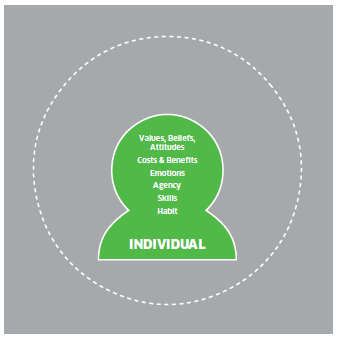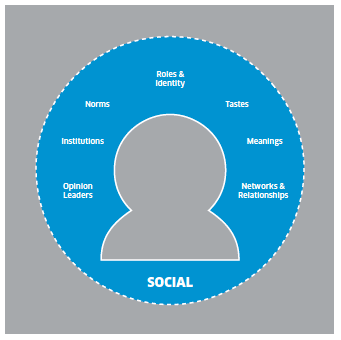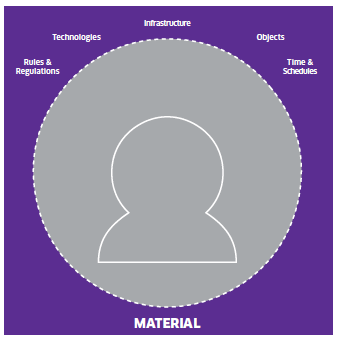Influencing behaviours - moving beyond the individual: ISM user guide
A user guide to the individual, social and material (ISM) approach to influencing behaviours.
UNDERSTANDING ISM
Within each of the three ISM contexts there are a number of factors which influence behaviours.
INDIVIDUAL - factors that shape behaviour
Values, Beliefs, Attitudes: The basic elements of an individual's motivational system, moving from the most abstract and broad based values ( e.g. pursuit of wealth or power), through beliefs or more particular worldviews ( e.g. that we should preserve the environment for future generations) to attitudes, which are individual's views on specific things such as objects, activities or other people ( e.g. I should not have to pay more for sustainable products).
Costs & Benefits: The cost/benefit calculation is the basic method of decision making, in which the perceived benefits (or 'utility') of acting are weighed against the perceived costs of doing so, including non-monetary costs such as time ( e.g. deciding whether the extra time spent walking to work is worth the health and environmental benefits). However, recent research has shown that much of this decision making is based on mental shortcuts, which can introduce errors, rather than effortful calculations.
Emotions: How people feel about something - their emotional response - is one aspect in their behavioural decision making ( e.g. fear, virtuousness or apathy). Some theories contrast 'hot' evaluations, based on emotions, with 'cold' evaluations, based on attitudes and rational choice.
Agency: Agency relates to self control and a person's confidence that they can undertake the behaviour in question, and see it through to completion. It usually relates to a specific object or situation ( e.g. installing and using microgeneration technologies in the home), but people can also be described as 'low agency' (generally lacking in confidence).
Skills: Skills are the things a person needs to know in order to carry out a behaviour. These include both procedural knowledge ('know how') and factual knowledge ('know what') ( e.g. fuel efficient driving techniques).
Habit: Habits are those behaviours which are undertaken automatically and frequently, with little conscious thought, and usually in the same time or place. These can also be understood as routines ( e.g. commuting by car or using the tumble drier even in good weather).

The range of factors that influence people's behaviours show that people are not necessarily conscious of the influence on their behaviours, nor are they always based on thinking things through on a 'rational' basis.
SOCIAL - factors that shape behaviour
Opinion Leaders
Opinion leaders can be thought of as individuals who have a
strong influence over others, for instance in shaping social norms.
In social networks, these people could be network nodes, who
connect together numerous others. In everyday life, examples could
include faith leaders or celebrities.
Institutions
Institutions influence how groups of individuals behave when
they are engaging in particular activities or interacting with
other people. Institutions can be formal (such as the legal system)
or more informal (such as family life). In either, shared
expectations about how members should behave are transmitted (
e.g. eating together as
desirable). Shared understandings may also take shape as explicit
rules and regulations.
Norms
People's perception of how other people (especially
'significant' others) would view their behaviour. In turn these
perceptions have a strong influence on the behavioural decisions
that people make (
e.g. people being aware that
they are not supposed to fly for domestic trips, but observing
family, friends and others doing it).
Roles & Identity
Roles relate to a person's different repertoires of
behaviours and attitudes, based on the role they are fulfilling at
the time (
e.g. mother, employee, football
supporter
etc.). The related concept of
identity is a person's innate sense of who they are (
e.g. being a good person or
identifying as a 'green').
Tastes
Tastes can be understood as preferences through
which people signal their belonging to particular social groups (
e.g. kinds of music listened
to, or table manners). These preferences are collectively
developed, and are based on shared understandings of appropriate
and desirable conduct.
Meanings
Meanings are culturally constructed understandings
of daily life which can include images, ideas, metaphors, and
associations. These meanings effectively set the frame for a
behaviour or practice, and in so doing influence how it is
undertaken, and how it is understood (
e.g. smoking in popular culture
used to mean sophistication and glamour, but now is more likely to
mean an unhealthy lifestyle).
Networks & Relationships
Connections between individuals, which people
identify and draw upon in identifying and carrying out possible
courses of action (this is sometimes called 'social capital'). In
aggregate, social networks can help to explain how ideas,
innovations and behaviours can spread (
e.g. growing your own
food).

MATERIAL - factors that shape behaviour
Rules & Regulations
At their most basic, rules and regulations are set
out by formal institutions, such as government, to prescribe or
prohibit certain kinds of behaviour (
e.g. through the taxation
system). Yet rules and regulations are also implicit, for instance
determining appropriate conduct for individuals in informal
institutions (
e.g. not disposing of
recyclable materials in the general waste bin in the
workplace).
Technologies
Technology is sometimes contrasted to behaviour, in
that techno-fixes are presented as ruling out the need for
individuals to change their behaviour. However, individuals and
technologies interact, and this can influence the effectiveness of
a technology in terms of its desired impact (
e.g. smart meters and how they
are used in practice). This interaction also enables new practices,
and the meanings of these practices, to spring
up and take hold quickly (
e.g. tweeting).
Infrastructure
Hard infrastructure relates to the firm boundaries
to people's behavioural choices presented by the environments in
which they live (for example, without a bus service, there will be
no chance of bus use). Such factors can often prevent even
motivated people from undertaking the behaviour in question.
Alongside hard infrastructure, soft infrastructure emphasises
features of everyday life which also bound individual action, but
are not concrete (see Time & Schedules, and Rules &
Regulations).
Objects
Many behaviours (
e.g. cycling to work) involve
the use of objects (
e.g. a bike, cycle racks at
work), and the lack of necessary objects can stop a practice from
being undertaken. As with technologies, objects and individual
users interact, such that sometimes the object can 'act back' on
its owner and heavily influence how much time an individual spends
on which practices (
e.g. waste in the home 'acts
back' on the householder who spends time cleaning and sorting
recycling for collection).
Time & Schedules
Time is a finite resource that gets used in the
course of carrying out everyday activities. Like money, it is a
scarce resource that people have to allocate across competing
demands. Changes in schedules (
e.g. set by formal
institutions) can often result in changes in individuals'
practices, for instance, school hours and commuting habits.

A further ISM case study is provided opposite. The example of using mobile phones whilst driving illustrates that using traditional policy levers of information and regulation can be insufficient against fast growing or entrenched social practices. By considering the various factors that influence behaviours - including the social factors - ISM can provide a different perspective which may prove to have more traction on these types of behaviours.
UNLOCKING MOBILE PHONE DRIVING
By the early 2000s, researchers began to present substantial evidence showing an increased risk of road accidents due to drivers using mobile phones*. Legislation on the use of mobile phones while driving is reserved to Westminster. The UK Government moved to address the issue by introducing UK wide legislation banning the use of handheld mobile phones and similar devices while driving. Initially this reduced reported levels of handheld phone use while driving, but evidence started to emerge from 2005-2007 that the proportions were gradually starting to increase again. Accordingly the UK Government increased the on-the-spot penalty (from £30 to £60), and added an automatic three points to the driver's licence. Advertising about the dangers of mobile phone driving (and the new penalties) was also undertaken as part of the Department for Transport's Think! campaign. Again, evidence suggests handheld phone use decreased initially, before beginning to rise again.
The case of using mobile phones whilst driving illustrates how even the 'stiffest' measures - prohibitive legislation with automatic penalties attached - can be insufficient against fast growing social practices. In ISM terms, traditional policy levers of providing information and regulation have not been enough to curb undesirable behaviour. The UK Government has been looking at alternative approaches, which in combination may prove to have more traction on this behaviour, while Police Scotland continue to actively target people who use mobile phones whilst driving.
* See, for example, Laberge-Nadeau C, Maag U, Bellavance F, Lapierre SD, Desjardins D, Messier S, Saïdi A, 2003. Wireless telephones and the risk of road crashes. Accident Analysis and Prevention 35(5): 649-60.
An ISM approach to tackling mobile phone use while driving would look to address a range of key factors, giving rise to the following ideas to strengthen the influence of existing interventions:
Individual:
- Costs & Benefits: Show that it's not worth the risk by publicising prominent cases in which people have been caught and prosecuted for mobile phone driving, including the loss of their licence.
- Habits: Encourage people to plan their communications before they travel, in the same way they might go to the toilet before they set out, or provide visual reminders ( e.g. Road Safety Scotland previously developed mobile phone shaped in car air fresheners as a visual reminder of the risks and penalties involved).
Social:
- Norms: Work to reshape social norms by making mobile phone use while driving socially unacceptable. This might include giving messages about only making calls when it is safe to do so; or empowering people to end calls when they suspect the person at the other end is driving.
- Meanings: Weakening the idea of the car as 'personal space' could lead to people being more ready to change their established in car behaviours in line with social pressures and rational risk based arguments. This could have dividends for other policies ( e.g. smoke-free places).
Material:
- Time & Schedules: Encourage drivers to schedule mobile phone calls as part of rest breaks ( e.g. with adverts in service stations); or work with courier companies, taxi firms and others employing drivers to introduce systems and itineraries that mean they don't need to make calls while on the move.
Contact
There is a problem
Thanks for your feedback